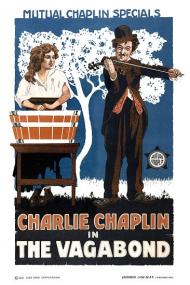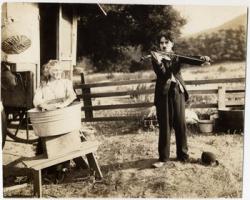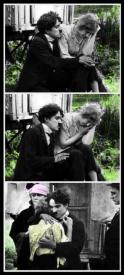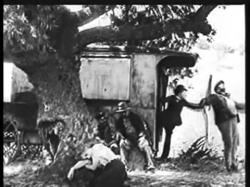Movie Review
The Vagabond

US Release Date: 07-10-1916
Directed by: Charles Chaplin
Starring▸▾
- Charles Chaplin, as
- Street Musician
- Edna Purviance, as
- Girl Stolen by Gypsies
- Eric Campbell, as
- Gypsy Chieftain
- Leo White, as
- Old Gypsy Hag
- Lloyd Bacon, as
- Artist
- Charlotte Mineau as
- Girl's Mother
![3.25 star[s] out of 4](http://www.threemoviebuffs.com/static/images/global/featured_gold_stars.png)

The Little Tramp plays his violin for the gypsy girl.
In 1916, when this movie was released, Charles Chaplin was the most famous person on the planet. He remains, even today, one of the most iconic figures ever to emerge from the art form known as the movies. His movies are timeless partly because they always seemed old-fashioned even for the times they were made. His characters are like something out of Dickens. His villains wear huge fake mustaches and his women are helplessly sweet natured and girlish.
The Vagabond has the impoverished Little Tramp as a violinist playing for change in a bar. He pisses off some rival musicians and gets chased around a bit. Next he wanders out into the countryside and encounters a pretty young gypsy girl (Edna Purviance). She is abused by the cruel old hag and brutish gypsy chieftain (Eric Campbell) she lives with. The Little Tramp plays his violin for her with comical results. But alas the old hag and gypsy chieftain put a stop to it and give her a severe beating.
Of course Charlie must come to her rescue!
He grabs a big stick, climbs a tree, and one by one hits all of the gypsy men over the head, knocking them unconscious. The brutish man awakens and attacks Charlie but the gypsy girl repays the favor by hitting the man over the head with the big stick. Charlie and the girl make their escape in the gypsy wagon.
Blissfully happy, the Little Tramp sets up camp with the gypsy girl and they begin a life together with Charlie sleeping outside on the ground of course. An artist (future director Lloyd Bacon) comes along and draws the girl’s picture while she is out filling a pail with water. He uses this sketch to paint her portrait which gets hung in a gallery and guess what? It turns out she is really the daughter of wealthy parents and was kidnapped by the gypsies!
There are a couple of unusual things about this movie. One is the fact that it has no title cards at all. The story is told from the pictures only. And two it has a happy ending, which anyone familiar with Chaplin’s work knows is rare. The Vagabond is not one of his funniest movies but it is amusing and charming.
![3 star[s] out of 4](http://www.threemoviebuffs.com/static/images/global/featured_gold_stars.png)

Charlie Chaplin and Edna Purviance in The Vagabond
Chaplin's early professional life (prior to film) consisted of the uncertainty of vaudeville employment. Chaplin sang, danced and played the violin for very modest pay. "Since the age of sixteen I had practised from four to six hours a day in my bedroom. Each week I took lessons from the theatre conductor or from someone he recommended." Chaplin wrote in his autobiography, "My Life in Pictures".
At the start of The Vagabond, the Tramp is playing violin outside a bar for change tossed at him from any passerby. Chaplin has been quoted as saying, “If you want to understand me, watch my movies.” As he came from poverty, the Tramp was a natural extension of who he was. No doubt a teenage Chaplin playing Violin at some dive could have made him feel very much like a bum begging for money. Vaudeville was never considered a classy form of entertainment.
His co-star here is his own discovery, Edna Purviance. She was not even attempting to be an actress when he cast her in her first film, A Night Out (1915). The scene where the Tramp washes her is quite reflective. Purviance would continue to appear in many of Chaplin's silent films. Although they were romantically linked early on, they never married. Her career pretty much ended when she stopped appearing in his silent films, yet he reportedly kept her on the payroll until she died in 1958.
Like so many of Chaplin's early films, The Vagabond is not strong on plot. It is however, typical Chaplin showing that love don't cost a thing. He saves the girl from an abusive situation and she in turn chooses to keep him around, even after learning she is wealthy. The Vagabond may very well be one of Chaplin's more personal early shorts.

Edna Purviance, Charlie Chaplin and Eric Campbell in The Vagabond.
Chaplin was the master of comedy pathos and this short is the perfect demonstration of that. The slapstick antics of the Little Tramp are contrasted with the sadness of his near loss of the girl he loves. There is a happy ending though. Something I wonder if Chaplin would have included if he had made this in his later career, as so often it seems, the Tramp would wander often alone at the end of a film.
Silent films of the teens tend to be simpler and rougher than those of the 20s. Cameras tended to be stationary and the acting more overdone and melodramatic, both of which are true about this movie.
Chaplin gets around the immovability of the camera in a couple of clever ways however. During the scene where the Tramp is being chased through the bar, around the corner and then back through the bar repeatedly, is handled through just two camera setups, one inside and one outside, but through some clever and tight editing, the chase flows beautifully and more than overcomes the stationary camera limitations.
As for the acting, Chaplin plays the Tramp as beautifully as ever and Edna Purviance is fine as the girl, but the villains are horribly over the top. The cruel Gypsy and the Hag are both wearing ridiculous amounts of makeup and move in an exaggerated manner that was far too common of the time.
Chaplin was one of the great talents and even in 1916, when his finest work was still in front of him, he knew how to entertain, after all, he'd been doing it all his life.
Photos © Copyright Mutual Film (1916)
